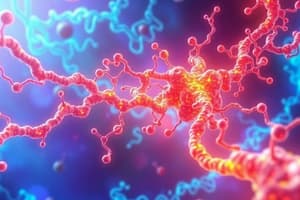Podcast
Questions and Answers
What is the purpose of the urea cycle?
What is the purpose of the urea cycle?
- Synthesis of glucose
- Excretion of nitrogen as urea (correct)
- Transporting amino acids
- Production of ATP
Which molecule serves as a 'vehicle' for the removal of NH2 groups in transamination?
Which molecule serves as a 'vehicle' for the removal of NH2 groups in transamination?
- Citrulline
- Glutamate (correct)
- Aspartate
- Arginine
What is the rate-limiting enzyme in the urea cycle?
What is the rate-limiting enzyme in the urea cycle?
- N-acetylglutamate
- Aminotransferases
- Carbamoyl phosphate synthetase I (CPS-1) (correct)
- Ornithine
Which process involves the excretion of excess bicarbonate (HCO3-)?
Which process involves the excretion of excess bicarbonate (HCO3-)?
What is the role of ornithine in the urea cycle?
What is the role of ornithine in the urea cycle?
Which molecule is synthesized during the urea cycle?
Which molecule is synthesized during the urea cycle?
What is the function of N-acetylglutamate in the urea cycle?
What is the function of N-acetylglutamate in the urea cycle?
What is the key function of fumarate in the urea cycle?
What is the key function of fumarate in the urea cycle?
Flashcards are hidden until you start studying
Study Notes
- Amino acid catabolism involves deamination, where nitrogen is a crucial building block, leading to nitrogen intake, excretion, and balance.
- Transamination is a process where the amino group is transferred from one amino acid to an α-keto acid by aminotransferases to form glutamate, acting as a "vehicle" for the removal of the NH2-group.
- Oxidative deamination is another biosynthetic process involving the conversion of glutamate to α-ketoglutarate, leading to the removal of NH2 through the citric acid cycle.
- Urea cycle in the liver plays a crucial role in excreting nitrogen as urea, involving various steps such as carbamoyl phosphate synthesis, ornithine metabolism, and the synthesis of arginine and fumarate.
- The purpose of the urea cycle includes the excretion of nitrogen as urea, elimination of excess bicarbonate, synthesis of arginine, and production of fumarate.
Studying That Suits You
Use AI to generate personalized quizzes and flashcards to suit your learning preferences.




